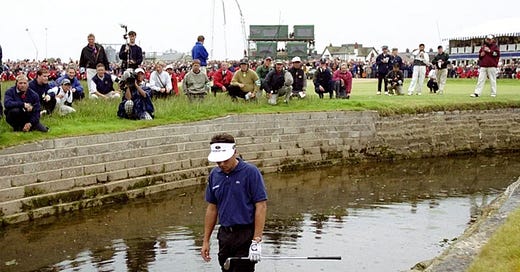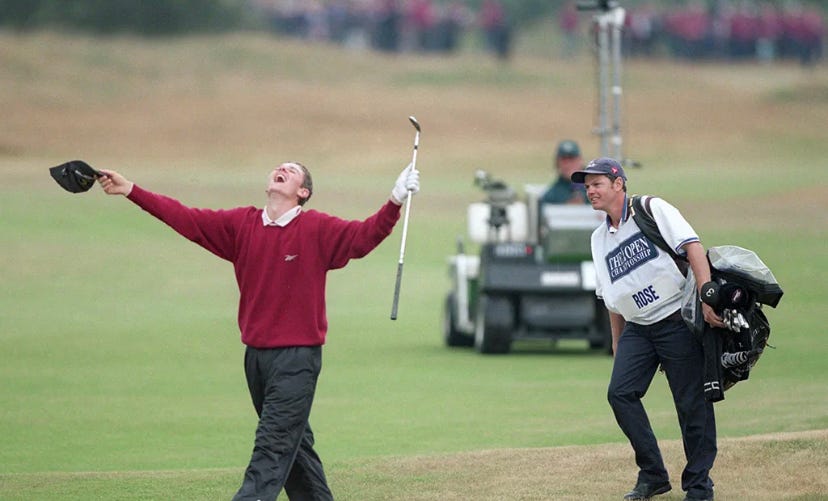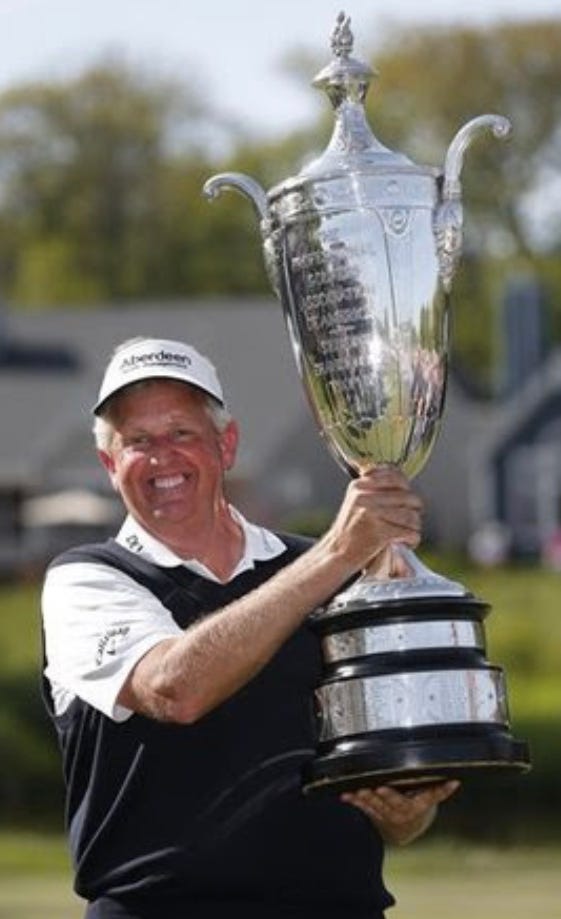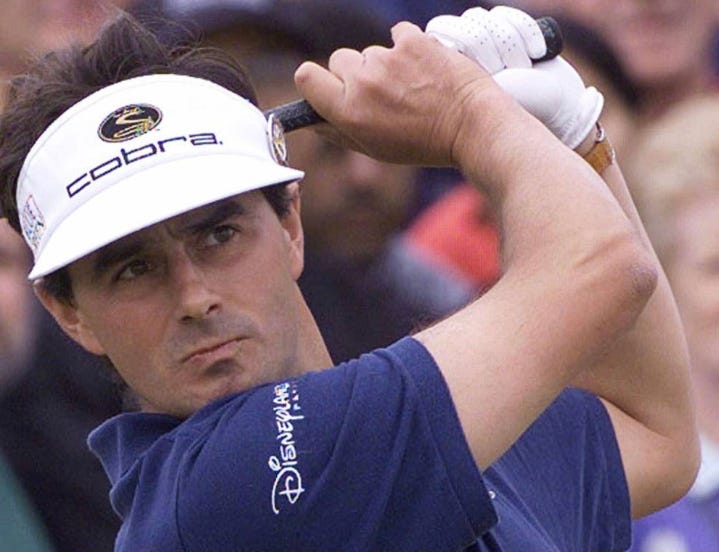Van de Velde in the Burn
Growing up on the East Coast of Scotland, taking at least a passing interest in golf is kind of a prerequisite. We have some of the oldest, and finest, golf courses in the world all around us and opportunities are often there to take a swing or to watch others do so. I have loved the idea of golf from being a very small child and have dabbled over time but it is not something that I have had the opportunity to pursue properly yet. I will save that for retirement!
In terms of watching though, I have been an avid viewer, particularly of, but not confined to, the majors, since I was young. I have marvelled at the beauty of Augusta, revelled in the thrill of the Ryder Cup and winced as the players have struggled with tough US Open courses like Oakmont and Winged Foot. However, as this week is the oldest major of the all, The Open Championship, I thought there was no better time to write about it.
I have early memories of happenings at the Open such as Faldo winning in 1992 at Muirfield, John Daly besting Constantino Rocca in a playoff at St Andrews in 1995 and Justin Leonard continuing a streak of American victories at Troon in 1997 but the first year that I truly remember being fully engaged from start to finish was the 1998 edition at Royal Birkdale. The tournament itself was won by American Mark O’Meara, backing up his victory in that year’s Masters, but it was the performance of a young English amateur by the name of Justin Rose (he went on to have quite a decent career and is well in the mix this year, 26 years later!) that hooked me in. No one really noticed when he carded a very average 72 on the first day, but on the Friday he sprang to life, and national attention, with a stunning 66 to leave him on 4 under par for the tournament. With the eyes of the world on him, in the final group, he shot 75 on the Saturday in difficult conditions, not a great score but enough to keep him in touch. He finished with a 69 on the Sunday, capped off with an incredible shot on the 18th, to finish in fourth position and only two behind the leaders. A brilliant performance and one that got me even more interested in a sport that I was already keen on.
Imagine my excitement then when I discovered that the following year, the Open would be coming virtually right to my doorstep to be played at Carnoustie for the first time since 1975, 24 years previously. I couldn’t wait for the opportunity to watch all of the greats up close and personal. It is a rule at the Open, in order to grab the attention of younger fans, that everyone under the age of 16 is able to enter for free, as long as they have a ticket. At the time you could just rock up on the day, as long as you could convince a random adult to say that you were with them, and be permitted entry, but we were (as always) super organised and wanted to have tickets beforehand. I vividly remember my Dad taking me down to the Tourist Information Centre in Carnoustie, probably about 5 months before the tournament actually started, to pick up the precious things for not only the tournament but for the practice days too.
I was 14 by that point and deemed more than capable of jumping on the local bus to the golf course and back by myself each day (organisation coming first again, we of course did a dry run of this on the Sunday to ensure I knew where I was going). It also got me out of the house, and out of my Mum and Dad’s hair, for a full week of the holidays. As long as I had a bag filled with food and refreshments I was totally fine.
The plan for the practice days was to try and get as many autographs as possible, it being acceptable practice for these to be asked for before the tournament proper starts. Upon arrival, I wandered around for a while assessing the different vantage points and eventually decided on a spot between the 15th green and the 16th tee where the players had to walk a short distance along a path to move between the two. It was a great spot to see some putting and teeing off action, but also for grabbing those valuable signatures. I was reliably informed by some boys around me, who had obviously done this before, that in general players were happy to sign as long as you were polite and patient. This worked for most players and I was delighted when the first signature I got was that of the towering South African, Ernie Els. This was swiftly followed by many other greats although some players had particular rules, Tiger Woods wouldn’t sign anything until he had finished at the 18th each day (although I still managed to get him), and the only player I failed to get was the notoriously surly Colin Montgomerie (it is a fact that the only thing I actually witnessed him sign at all that week was a life size cardboard cutout of himself!).
For the first couple of practice days I just went by myself but towards the end of the second day, I bumped into some of my friends (this was before the days of having a mobile phone so we couldn’t just text and arrange a meeting) and we decided we would all go together after that. We spent the final warm up day wandering round all of the different facilities that the event had to offer (the virtual tee shot was a favourite) grabbing as many freebies as we could from different stalls and looking at the player groupings to work out who we wanted to follow the next day. It was also on the bus home that day that we bumped into a group of Americans, one of whom claimed to be the brother of WWE wrestler ‘Stone Cold’ Steve Austin, the hottest star in that business at that time. We weren’t entirely sure that we bought his story but he had a picture with him and they gave us each a beer so they were ok by us.
On the Thursday morning we arrived bright and early. We had decided we wanted to watch some of Sergio Garcia’s round (the young Spaniard had only just broken onto the scene at that point), I wanted to catch a bit of Els’s round and then we were going to brave the masses and try and follow Tiger. It was fun moving round from hole to hole, trying to get ahead of the crowds and get good positions to watch from but we decided that for the following days, it may be a better plan to find a good spot each day and watch the different groups coming through. We did this on the Friday and the Saturday and watched the play, and the drama, unfold.
Conditions were absolutely brutal that year, with high winds and some rain coupled with narrow fairways and thick rough meaning many struggled, and lots of the top players weren’t happy at all. Not one player got a score under par on the Thursday and that evening’s leader, Rod Pampling, then went on to hit an 86 the next day to not even make the cut! As the tournament progressed, it was a relatively unknown Frenchman, Jean Van de Velde, who had taken control and by the end of Saturday’s play, he was on level par and had a five shot lead over his nearest competitors. Undeterred by the conditions ourselves, we had watched a bit of his play on the Saturday and he looked incredibly composed under the pressure. Surely with such a lead he would hold his nerve.
For the final day’s play on the Sunday, we had decided that we wanted to be in the grandstand by the 18th green in order to watch everyone coming in over the course of the day. We took it in turns to go for walks and explore a bit, leaving others to hold onto the seats which were like gold dust as the day wore on. The weather was again not great and many players shot high scores. By the time they reached us, I think many were just happy that it was all over.
Midway through the afternoon there was a cheer as Paul Lawrie, who was from just up the road in Aberdeen, finished a tremendous round of four under par to leave himself at six over for the tournament. This was still six shots shy of where Van de Velde had been at the start of the day but the Frenchman was starting to struggle, dropping to three over by the 11th hole, and I remember my friend saying to me that he wouldn’t be surprised if Lawrie was right in the mix come the end. I though he was mad at that point but it turns out he was right.
As the rest of the players came through, the only one to have matched Lawrie’s clubhouse lead was Justin Leonard who had won the tournament two years previously. However, when Van de Velde reached the final tee, he still held a three shot lead over this mark and knew that, in all likelihood, even a double-bogey would win him the championship. He didn’t make a great start as he sent his tee shot way to the right, actually onto the adjacent hole, and just missing going into the water. Incredibly, rather than pitching up short of the notorious Barry Burn and having a fairly simple up and down, he decided to go for the green with his second shot. This was his first mistake. He sliced his shot and it came careering off the stand directly across from us and landed in the thick rough below. A huge gasp went around, followed by a deathly hush that came over the crowd. Had he completely lost control of his senses? We couldn’t believe what we were seeing. Meanwhile, his playing partner Parry found the green side bunker with his second and later chipped in for a birdie to finish one shy of Lawrie and Leonard.
Van de Velde moved forward to assess his lie, deep in the grass. He wandered towards the burn to assess his options before returning to his ball. He aimed to hit it over the water and onto or near the green but hit the ball too thickly and it dropped into the burn. Nobody had ever seen anything like this before. Ordinarily, a player would take a drop shot and chip over but Jean noticed that his ball was sitting up slightly in the water. His brain obviously now in a very strange place, and much to our disbelief, he proceeded to take off his socks and shoes, roll up his trouser legs and drop into the water himself, thinking he may be able to take the shot. This all made for one of the most famous scenes in golfing history. Eventually, he seemed to come around and realised this was a ridiculous idea and took the drop instead.
This time, his shot (his fifth after the drop) cleared the burn and flopped into the hole side bunker, right next to Parry’s. He would need to chip in to win and avoid a playoff. By this point I had phoned my Dad to see if he was recording this as I was hoping there may be a shot of me on the TV during what would surely go down as one of the most famous finishes ever (He was but there wasn’t).
Parry played first and, as if to rub salt into the wounds, that was when he chipped in for his birdie. Van de Velde couldn’t replicate this, chipping to around eight feet away from the hole, but did hold his nerve to make that putt and join Lawrie and Leonard in a four hole playoff. We all knew by that point though that his mind would be gone and that he would be the least likely of the three to be triumphant.
As the players headed back to the 15th tee for the first of four holes, the weather turned a bit worse and I have a memory of Billy Connolly coming out onto the balcony of the hotel and telling jokes for the crowd at the eighteenth (including ourselves) to keep them entertained until the players reached us. By the time they did, Lawrie held a one shot lead and then birdied the last to cement the most unlikely of victories in the most extraordinary of circumstances. Unfortunately for him, most people will remember the end of the 1999 Open Championship for the antics surrounding Jean Van de Velde rather than the person that won, but sometimes that is just the nature of sport. He will always have it on his CV.
I will always count myself thankful that I was there to witness such incredible scenes and my passion for golf has continued ever since. If the finish this weekend at Royal Troon is anywhere near as exciting, it will certainly be must watch.









